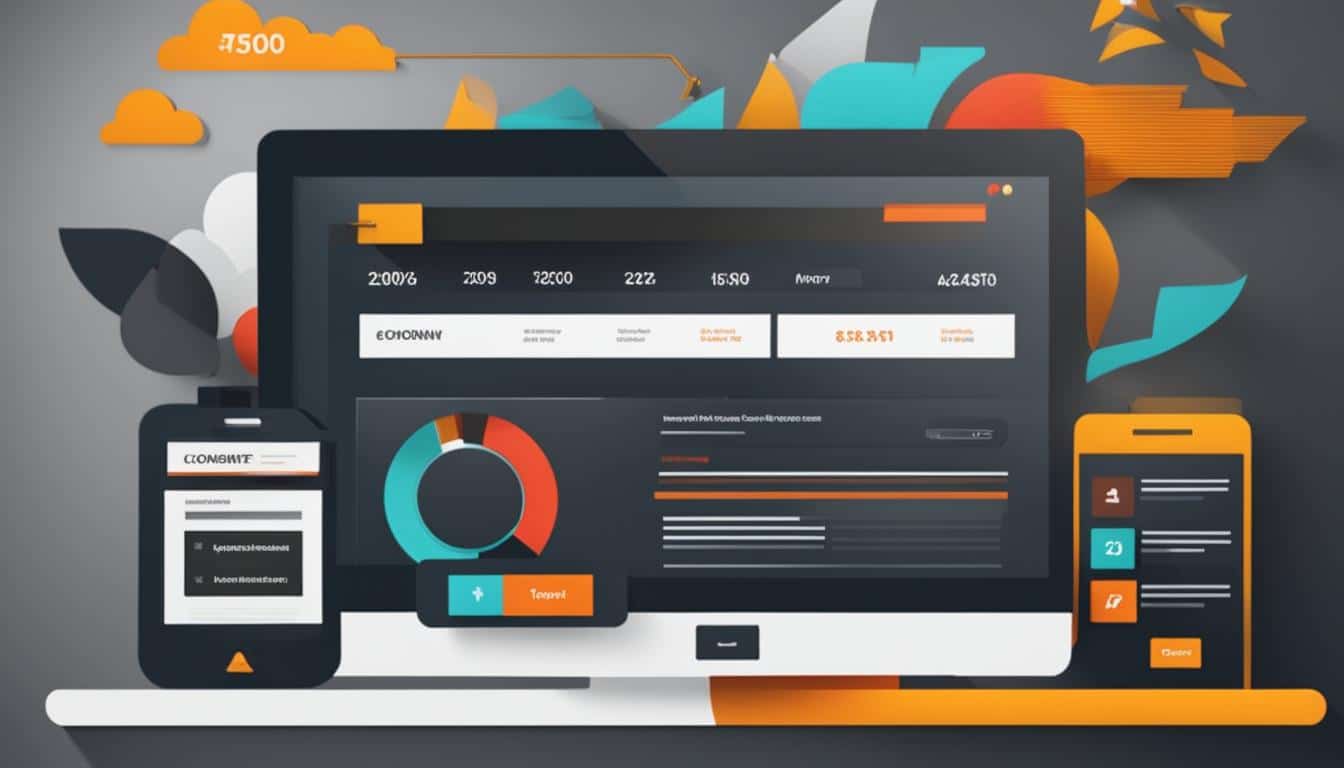
Landing page optimization is a crucial aspect of digital marketing success. By implementing effective strategies and best practices, you can improve the performance and conversion rates of your landing pages. In this section, we will explore essential tips for optimizing your landing pages and increasing your website's success.
Key Takeaways:
- Optimizing landing pages is essential for digital marketing success and improving conversion rates.
- Implement effective strategies and best practices to enhance landing page performance.
- Consider the design, mobile optimization, and clear call-to-action when designing high-performing landing pages.
- Utilize SEO techniques such as keyword research and on-page optimization to improve landing page visibility.
- Incorporate social proof and exit popups to increase trust and encourage visitor engagement.
What is Landing Page Optimization (LPO)?
Landing Page Optimization (LPO) is a critical process in digital marketing that involves making incremental improvements to various elements of a landing page. The goal of LPO is to drive leads, sign-ups, or sales by optimizing each component of the landing page to maximize conversions. This process includes implementing best practices, utilizing data-backed insights, and conducting A/B testing to determine the most effective variant for your target audience.
By optimizing your landing pages, you can improve their effectiveness and increase the return on investment (ROI) of your marketing campaigns. LPO focuses on enhancing the user experience, aligning the landing page with the campaign's objectives, and optimizing the page's performance to drive higher conversion rates. It involves refining the design, layout, copywriting, and overall user flow to create a seamless and persuasive journey for your visitors.
Conversion Rate Optimization (CRO) is an integral part of LPO. It refers to the systematic process of increasing the percentage of visitors who take the desired action on a landing page. Through continuous testing, data analysis, and optimization, LPO aims to maximize conversions and achieve the desired business outcomes.
When implementing LPO, it is crucial to consider factors such as user behavior, preferences, and expectations. By understanding your target audience and their motivations, you can tailor your landing page to effectively communicate your value proposition and encourage visitors to take action.
What is Landing Page Optimization (LPO)?
When to Use a Landing Page
Landing pages play a critical role in maximizing the success of your marketing campaigns. By directing relevant traffic to purpose-built landing pages, you can optimize your conversion rates and minimize wasted advertising spend. When running campaigns, especially paid ones, it is essential to create specific landing pages that align with the campaign's objectives and messaging.
Instead of sending visitors to generic pages like the homepage, utilizing landing pages tailored to each campaign allows you to provide a focused and seamless user experience. By aligning the landing page content with the specific campaign, you can speak to the needs, desires, and pain points of your target audience more effectively.
Furthermore, using landing pages for multi-channel traffic can simplify your marketing funnel and enable more accurate tracking and testing. By creating dedicated landing pages for different traffic sources, such as social media or email campaigns, you can gather valuable insights and optimize your campaigns based on the performance data specific to each channel.
Table: Benefits of Using Landing Pages for Different Campaigns
| Campaign Type | Benefits of Using Landing Pages |
|---|---|
| Paid Campaigns | – Improves ad relevance and quality score – Increases conversion rates and ROI – Enables precise tracking and performance measurement |
| Promotional Campaigns | – Allows for quick and targeted messaging – Expedites time-sensitive promotions – Focuses visitor's attention on specific offers |
| Multi-channel Traffic | – Simplifies the marketing funnel – Enables more accurate tracking and testing – Provides data insights for optimization |
By leveraging landing pages for relevant campaigns, paid campaigns, and multi-channel traffic, you can enhance your marketing efforts, increase conversions, and drive the success of your digital campaigns.
Designing High-Performing Landing Pages
When it comes to designing high-performing landing pages, there are several key factors to consider. First and foremost, mobile optimization is crucial in today's digital landscape. With the majority of internet users accessing websites through mobile devices, it's essential to ensure that your landing page is fully responsive and optimized for viewing on smartphones and tablets.
A simple design is also important for creating an effective landing page. Minimalist and clean layouts not only improve the visual appeal but also help to eliminate distractions and guide visitors' attention towards your call-to-action (CTA). Utilize white space strategically to create a sense of balance and make your CTA more prominent. Remember, when it comes to design, less is often more.
To ensure that your landing page design aligns with your objectives and resonates with your target audience, consider creating a creative brief. A creative brief is a document that outlines the goals, target audience, key messages, and design preferences for your landing page. This serves as a roadmap for your design team and helps streamline the design process. By providing clear guidelines and expectations, you can ensure that your landing page design is aligned with your brand and effectively communicates your message.

In conclusion, designing high-performing landing pages requires careful consideration of mobile optimization, simplicity in design, and the use of creative briefs. By following these principles, you can create landing pages that not only capture the attention of your audience but also drive conversions and contribute to the overall success of your digital marketing campaigns.
Improving Landing Page Performance with SEO
When it comes to landing pages, optimizing for search engines is essential to improve visibility and drive organic traffic. Incorporating effective SEO strategies can significantly enhance the performance and success of your landing pages. Here are some key areas to focus on when optimizing your landing pages:
Keyword Research
Before creating or optimizing your landing page, conducting thorough keyword research is crucial. Identify relevant keywords that align with your target audience's search intent and incorporate them naturally into your content. By using the right keywords, you can increase the chances of your landing page appearing in search engine results, attracting more organic traffic.
On-Page Optimization
Optimizing various on-page elements is vital for both search engines and users. Ensure that your landing page has a descriptive title tag, compelling meta description, and relevant headers (H1, H2, H3) that reflect your target keywords. Additionally, optimize your images with alt tags and compress them for faster loading speeds. These on-page optimization techniques can improve your landing page's visibility and user experience.
Domain Purchasing
When selecting a domain name for your landing page, consider buying a well-branded domain that aligns with your overall marketing strategy. A memorable and relevant domain can increase trust and credibility, which can impact your landing page's performance. Additionally, ensure that the domain name is easy to type, spell, and remember to maximize its effectiveness.
| Benefits of Landing Page SEO Optimization | Benefits of Landing Page SEO Optimization |
|---|---|
| Increased organic traffic | Higher conversion rates |
| Enhanced visibility in search engine results | Better user experience |
| Greater credibility and trust | Improved ROI on marketing campaigns |
Implementing SEO optimization techniques for your landing pages can lead to significant benefits, including increased organic traffic, higher conversion rates, enhanced visibility, and a better user experience. By conducting keyword research, optimizing on-page elements, and choosing a well-branded domain, you can maximize the impact of your landing pages and improve the overall success of your digital marketing efforts.

Remember that SEO is an ongoing process, and it's important to regularly monitor your landing pages' performance, analyze data, and make necessary adjustments. By continuously optimizing your landing pages for SEO, you can stay ahead of the competition and drive more targeted traffic to achieve your business goals.
Leveraging Social Proof and Exit Popups
Social proof is a powerful tool that can significantly impact the success of your landing pages. By incorporating testimonials, reviews, case studies, or ratings, you can build trust and credibility with your visitors. Testimonials, in particular, provide real-life examples of how your product or service has benefited others, making it easier for potential customers to make a decision. When selecting testimonials, choose ones that highlight different aspects of your offering and showcase the diversity of your satisfied customers. This variety will resonate with a wider audience and increase the chances of conversion.
To further boost engagement and conversions on your landing pages, consider using exit popups. An exit popup is a last-minute offer that appears when a visitor is about to leave your page. This provides an opportunity to entice them with a special discount, limited-time offer, or exclusive content in exchange for their contact information or immediate purchase. By providing an attractive incentive, you can capture their attention and potentially turn a lost visitor into a valuable lead or customer.
"Testimonials provide real-life examples of how your product or service has benefited others, making it easier for potential customers to make a decision."
When implementing exit popups, it's important to strike a balance between being engaging and not overly intrusive. Make sure the popups are visually appealing and clearly convey the value proposition of the offer. You can also experiment with different triggers, such as timed popups or exit intent technology that detects when a user is about to leave the page. Additionally, personalizing the exit popup based on the visitor's browsing behavior or previous interactions can make the offer even more relevant and compelling.
Remember, social proof and exit popups are just two of the many strategies you can leverage to optimize your landing pages for conversions. It's important to continuously analyze and test different elements to find the combination that works best for your target audience. By understanding their needs, addressing their concerns, and providing compelling reasons to take action, you can create landing pages that drive results and contribute to the success of your digital marketing campaigns.
The Power of Social Proof and Exit Popups
Social proof and exit popups are highly effective techniques for maximizing conversion rates on landing pages. By showcasing testimonials and incorporating exit popups, you can build trust, overcome objections, and offer irresistible incentives to visitors, increasing the chances of conversion. These strategies tap into the psychological principles of influence and persuasion, leveraging the power of social validation and the fear of missing out (FOMO) to drive action.
Social proof provides evidence of the value and quality of your offerings. When potential customers see that others have had positive experiences with your product or service, they are more likely to trust your brand and make a purchase. Testimonials, reviews, and ratings serve as endorsements from satisfied customers, making it easier for prospects to make a decision.
Exit popups, on the other hand, allow you to make a last-ditch effort to capture the attention of visitors who are about to leave your page. By offering a special discount, limited-time offer, or exclusive content, you can entice them to stay and take the desired action. This strategy takes advantage of the psychological principle of loss aversion, where people are more motivated to avoid losses than to gain rewards.
When using social proof and exit popups, it's important to ensure that they are implemented seamlessly into your landing pages. Testimonials should be strategically placed to reinforce key selling points and address common objections. Exit popups should be visually appealing and offer a compelling value proposition. By A/B testing different variations and tracking the results, you can refine your approach and optimize your landing pages for maximum conversions.
Conclusion
In conclusion, landing page optimization is a continuous process that requires attention to detail and data-backed decision-making. By implementing the tips and best practices discussed in this article, you can optimize your landing pages for better performance, increased conversions, and improved ROI.
Remember to continuously test, analyze, and iterate your landing pages to ensure ongoing success in your digital marketing campaigns. With a well-designed landing page, strategic use of keywords, and persuasive social proof elements, you can create a compelling user experience that drives results.
So, whether you're looking to generate leads, increase sign-ups, or boost sales, landing page optimization is a critical component of your marketing strategy. By following the steps outlined in this article, you can optimize your landing pages to achieve your desired goals.
FAQ
What is landing page optimization?
Landing page optimization (LPO) is the process of making incremental improvements to each element of a landing page to drive leads, sign-ups, or sales. It involves starting with best practices and data-backed insights and testing different variants to determine which one performs best with your target audience. LPO aims to increase the effectiveness of landing pages and improve the return on investment (ROI) of marketing campaigns.
When should I use a landing page?
Landing pages should be used when running relevant campaigns, especially paid campaigns. Sending visitors to non-campaign-specific pages, such as the homepage, can result in wasted advertising spend and lower conversion rates. It is recommended to create landing pages for each source of traffic to simplify the funnel and enable more effective testing. Additionally, landing pages are useful for quickly launching promotional campaigns or addressing critical messages without modifying the main website.
How do I design an effective landing page?
Designing an effective landing page involves considering various factors. It is important to understand the business objective and target audience of the campaign, as well as the goals and motivations of the visitors. The landing page should have a clear and specific call-to-action (CTA), maintain consistent branding, and be optimized for different devices. It is also essential to create a simple and focused design that eliminates visual clutter and guides the visitors' attention towards the CTA. Utilizing a creative brief and conducting A/B testing can further enhance the design and optimize the landing page for conversions.
How can I improve my landing page's SEO performance?
SEO optimization plays a vital role in improving the performance of landing pages. Conducting keyword research and incorporating relevant keywords into the landing page's content, headlines, and metadata can enhance its visibility in organic search results. On-page optimization techniques, such as optimizing images and using proper header tags, can further improve the page's SEO performance. It is also important to ensure that the landing page has a well-branded domain name and aligns with the aesthetic of other promotional materials.
How can I leverage social proof and exit popups on my landing page?
Social proof is a powerful tool for increasing trust and credibility on landing pages. Incorporating testimonials, reviews, case studies, or ratings can help persuade visitors to take action. Additionally, exit popups can be used to offer special discounts or incentives to visitors who are about to leave the landing page. By utilizing social proof and exit popups, you can optimize your landing page for conversions and encourage visitors to stay engaged.
What are some tips for ongoing landing page optimization?
Landing page optimization is a continuous process that requires attention to detail and data-backed decision-making. By implementing the tips and best practices discussed in this article, you can optimize your landing pages for better performance, increased conversions, and improved ROI. Remember to continuously test, analyze, and iterate your landing pages to ensure ongoing success in your digital marketing campaigns.











